Bid farewell: the sale of the mid-century at New York’s Four Seasons Restaurant

It’s just past noon on a late spring day at The Four Seasons Restaurant in New York. Co-owner Julian Niccolini, dressed in polished Oxfords and one of his many custom-made Thom Browne suits, examines the tables allocated for the all-important lunch reservations. Preternaturally calm waitstaff smooth over the crisp linen tablecloths as Alex von Bidder, Niccolini’s long-time business partner, calmly greets a handful of early guests as they ascend the wide travertine staircase. With the power hour unfolding with a kind of military grace, it’s almost impossible to imagine that this bastion of the New York dining scene will close its doors in just a few weeks. 'Some of us remain in a kind of denial,' says Niccolini, who began working at the restaurant in 1977, four years after arriving in the US. 'I’ve basically grown up within these walls, and I’ve seen the restaurant through many different chapters of New York history.'
From its inception, The Four Seasons Restaurant was a restaurant of singular ambition. A pair of vast rooms at the base of Mies van der Rohe’s Manhattan masterpiece, the 38-storey Seagram Building, the restaurant opened in 1959. Like the building itself, the restaurant’s construction was overseen by Seagram owner Samuel Bronfman and his architect daughter Phyllis Lambert, who lavished fastidious attention on every detail, birthing a truly modern Gesamtkunstwerk.
In keeping with the world’s foremost International Style building, the restaurant marries rectilinear clarity with an exquisite material palette. When an exhausted Mies retreated to Chicago, Philip Johnson, who would one day be considered the ‘dean’ of American architecture, was charged with designing the restaurant’s interior.
Faced with the scale of a small European train station, Johnson divided the space into two large dining rooms. In the Grill Room, he added magisterial 20ft-high panels of French walnut and installed a square bar beneath a Richard Lippold sculpture of hanging bronze tubes. For the somewhat more romantic Pool Room, a raised pool of white Carrara marble was installed as a visual anchor. Connecting the two spaces is a long, thin travertine-clad passageway known as Picasso Alley because it housed a 19ft x 20ft Picasso curtain created in 1919.
Johnson and Lambert’s design dream team also included lighting expert Richard Kelly; industrial designers L. Garth and Ada Louise Huxtable; and landscape architect Karl Linn. The project’s final budget amounted to the then-unprecedented sum of $4.5m, said to be more than the cost of the entire Guggenheim Museum.
Here, in the heart of Midtown Manhattan, was a new kind of establishment. Undeniably glamorous, but never gauche or glitzy, the restaurant was a paean to power itself, and the handsome travertine and glass space became the quintessential backdrop for the city’s post-war ambitions and dizzily status-conscious denizens. Heads of state, visiting royalty, newly minted yuppies and titans of industry all parked up to discuss business and seal deals.
Thankfully, the tables were far enough apart to facilitate dealmaking yet still allow for just a soupçon of eavesdropping (to be breathlessly reported by Page Six), while generous sightlines facilitated discreet stargazing. With a setting that never eclipsed its supernova clientele, The Four Seasons Restaurant always seemed to be the social arena of the moment. In 1962, the newly inaugurated President Kennedy celebrated his 45th birthday party in one of the restaurant’s private rooms, hours before Marilyn Monroe’s famous raspy serenade. In the 1980s, it was Chanel power suits, Ivana Trump and naked romps in the marble pool. The 1990s saw it become the de facto Condé Nast canteen (where US Vogue editor Anna Wintour, a regular diner, was once served a dead raccoon by a PETA protester).
'Everybody has eaten here,' says Niccolini, suggesting it’s easier to name the celebrities who have not dined here ('We’ve fed every president except Richard Nixon'). In 1979, Esquire coined the term 'power lunch to describe the restaurant’s sui generis blend of power and status. Jacqueline Kennedy Onassis christened the Grill Room 'the cathedral.'
But it couldn’t last. In recent years, this seat of 20th century might has become the object of much public combat, with von Bidder and Niccolini pitted against Aby Rosen, the Seagram Building’s owner. Rosen has also clashed with preservationists and Lambert, the restaurant’s visionary creator, by pushing for the removal of the Picasso curtain (which was painted for the ballet Le Tricorne and is now installed in the New-York Historical Society) and proposing structural changes to its landmark protected interiors. Unable to reach a new lease agreement, the owners decided to shutter the restaurant and reopen it elsewhere under the same name. Nevertheless, The Four Seasons Restaurant, as we know it, will cease to exist.
While most of the building’s iconic interior elements cannot be altered, its contents are due to be sold in a sale conducted by Chicago-based auction house Wright. 'The Four Seasons is the epitome of Power New York,' says founder Richard Wright. 'Having a drink at the bar, where I always felt obligated to order a martini, felt impossibly urbane. The richness of the interior, the hushed environment and the hypnotic ripple of the metal window treatments refute the idea of modernism being cold and clinical. The space elevates and inspires, which is why it has played a part in the important life moments of so many.'
For those who’ve celebrated a milestone at the restaurant or simply enjoyed a business lunch, its rich furnishings and tableware possess both intrinsic and talismanic power. 'It reminds me of when the Yankees relocated and the stadium’s contents were sold to the fans,’ says Niccolini. 'Our guests are desperate to own a piece of the city’s culinary and social history.'
Among the lots up for auction are the Grill Room’s five custom-built Knoll banquettes, the domain of the restaurant’s A-list habitués. 'Each day, Philip Johnson would take his lunch right here and order a single negroni,' says Niccolini, pointing out the Grill Room’s southernmost banquette. Other pieces for sale include upholstered 'Brno' chairs, originally designed for Mies’ Villa Tugendhat in Brno in the Czech Republic; polished bronze-topped 'Tulip' tables by Eero Saarinen from the bar area; Hans Wegner chairs from the Grill Room’s mezzanine, including the chair that JFK sat on during his birthday dinner; and the sofas that Johnson designed specifically for waiting guests.
'The Bronfman family and Phyllis Lambert, in particular, were like the Medicis of their time,' says Niccolini, listing the sheer number of items that were commissioned for the restaurant by its founders, determined to cast off the tradition-bound hauteur that was then standard in predominantly French fine dining restaurants. The Huxtables’ table and cookware, which features in the permanent collection of the Museum of Modern Art, also reflects this spirit of strident modernity.
Depending on who you ask, this pharaonic temple to modernism – with its expensive, indistinct food, expansive spaces and muffled ambience – is either completely démodé or more relevant than ever. What’s certain is that it won’t remain the same after the last service on 16 July, four days shy of its 57th birthday. 'This all will come to an end,' says Niccolini with a sanguine shrug. With help from advisers, including architectural critic Paul Goldberger, the owners have engaged a world-class architect to create a new iteration of The Four Seasons Restaurant. 'Again, the architecture will come first,' stresses Niccolini, almost conceding that the food has always been beside the point. 'People don’t go to restaurants just to eat; it’s a place for magic, tremendous architecture and beauty. We could never recreate this, but we will do something special.'
As originally featured in the July 2016 issue of Wallpaper* (W*208)
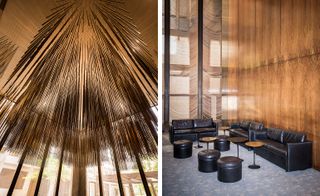
Pictured left: the spectacular Richard Lippold bronze sculpture in the bar, commissioned by Johnson in 1958, will remain in situ. Right: Johnson designed the salon-style ’Perching’ sofas for waiting guests although they were rarely used, given the military precision with which tables were allocated. Alongside them are ’Tulip’ tables, originally designed by Eero Saarinen in 1956 (the tables will be sold individually and as pairs)
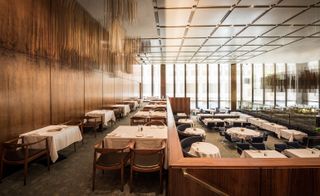
A view of the Grill Room from the north-east corner mezzanine (once derided as ’Social Siberia’ by gossip columnists). The mezzanine space features ’The Chair’, Hans Wegner’s archetypal design in leather and teak. Beyond, the room features custom banquettes designed by Johnson, and Mies’ custom ’Brno’ chairs. The French walnut panelling and Richard Lippold’s hanging sculpture will remain in the space in its next iteration
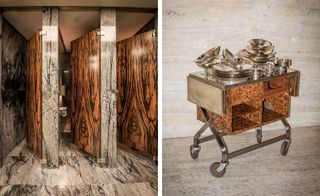
Pictured left: the men’s lavatory in its Mad Men glory, designed by Johnson. Right: designed by Johnson, the serving cart holds silver serving ware by L. Garth and Ada Louise Huxtable. Each piece is made of silver soldered metal (pairs of serving bowls begin at $500 and charges are estimated to begin at $1,000 a set)
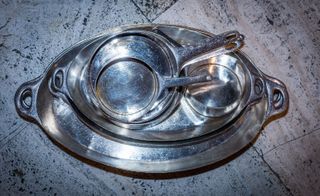
Serving ware: with a mandate to cast off the old-fashioned rituals of fine dining, everything in the restaurant had to exude American modernity. L. Garth and Ada Louise Huxtable designed all tableware, cookware and serving dishes

Pictured left: silver wine coolers designed by L. Garth and Ada Louise Huxtable, 1958–59 (auction estimate $1,000–1,500). Right: designed by L. Garth and Ada Louise Huxtable between 1958 and 1959, the stemware – some of which is in the collection of MoMA – also embraced a clean, modern aesthetic
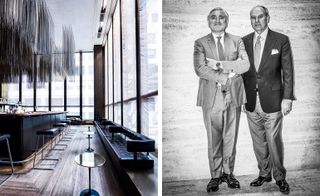
Pictured left: the bar features custom ’Tulip’ tables; bar stools of chrome-plated steel and leather, designed by Johnson and Mies van der Rohe; and custom banquettes by Philip Johnson and Associates. Right: The Four Seasons Restaurant’s co-owners Julian Niccolini (left) and Alex von Bidder (right) have run the bastion of mid-century elegance for two decades, and worked there for four. They now have plans to create a new restaurant in another architecturally significant space
INFORMATION
The Four Seasons auction will take place on 26 July. For more information visit the Wright auction house website
Photography: François Dischinger. Producer: Michael Reynolds
ADDRESS
99 East 52 Street, New York
Wallpaper* Newsletter
Receive our daily digest of inspiration, escapism and design stories from around the world direct to your inbox.
-
 Architecture and the new world: The Brutalist reframes the American dream
Architecture and the new world: The Brutalist reframes the American dreamBrady Corbet’s third feature film, The Brutalist, demonstrates how violence is a building block for ideology
By Billie Walker Published
-
 Danish manufacturer Zenvo Automotive’s Aurora is the true enthusiast’s hybrid hypercar
Danish manufacturer Zenvo Automotive’s Aurora is the true enthusiast’s hybrid hypercarZenvo Automotive dovetails Danish design culture with a love of high-end engineering and exceptional performance. We talk to the company’s Jens Sverdrup about its newest machine, the Aurora
By Jonathan Bell Published
-
 Taking off? XPeng Aero HT promises world’s first all-electric ‘Land Aircraft Carrier’
Taking off? XPeng Aero HT promises world’s first all-electric ‘Land Aircraft Carrier’Six wheels, six rotors, four seats and an aesthetic that bests even the boldest futurologist – Chinese manufacturer XPeng looks to the skies with this truck and its onboard flying machine
By Jonathan Bell Published
-
 Sculptor James Cherry’s always playful and sometimes strange lamps set New York's Tiwa Gallery aglow
Sculptor James Cherry’s always playful and sometimes strange lamps set New York's Tiwa Gallery aglow‘It was simultaneously extremely isolating and so refreshing’: Los Angeles-based sculptor James Cherry on brainstorming ‘From Pollen’ at New York’s Tiwa Gallery
By Diana Budds Published
-
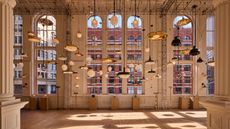 A celestial New York exhibition showcases Roman and Williams’ mastery of lighting
A celestial New York exhibition showcases Roman and Williams’ mastery of lightingLauded design studio Roman and Williams is exhibiting 100 variations of its lighting ‘family tree’ inside a historic Tribeca space
By Dan Howarth Published
-
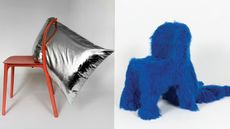 The Bouroullecs’ ‘Belleville’ chair reimagined 53 ways for La Source Garouste auction
The Bouroullecs’ ‘Belleville’ chair reimagined 53 ways for La Source Garouste auctionThe ‘Belleville’ chair is spliced, diced and furrified for La Source Garouste’s charity auction, by designers from Christian Louboutin to Constance Guisset
By Francesca Perry Published
-
 Brooklyn furniture studio Stillmade unveils its first collaborative design series
Brooklyn furniture studio Stillmade unveils its first collaborative design seriesStillmade brings to life the designs of four New Yorkers – Pat Kim, Danny Kaplan, Michele Quan and Mignogna Studio
By Pei-Ru Keh Published
-
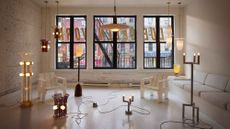 Blue Green Works's lighting champions a new aesthetic in American design
Blue Green Works's lighting champions a new aesthetic in American designManhattan-based design studio Blue Green Works fuses sensuality and masculinity to create mellow, mood-enhancing lighting with visual impact
By Pei-Ru Keh Published
-
 Blue Green Works introduces alluring new lighting collection
Blue Green Works introduces alluring new lighting collectionInspired by iconography, American design studio Blue Green Works introduces five new lighting ranges
By Rosa Bertoli Published
-
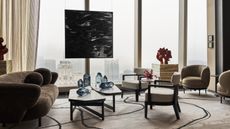 First look inside Centurion New York by Yabu Pushelberg
First look inside Centurion New York by Yabu PushelbergCenturion New York is an expansive new space for American Express’ ‘black card’ members. Its interior designers Yabu Pushelberg give us a tour
By Tilly Macalister-Smith Published
-
 Exclusive peek at artfully curated home in Jean Nouvel’s 53 West 53
Exclusive peek at artfully curated home in Jean Nouvel’s 53 West 53RR Interiors' latest furnishing project – 61A at 53 West 53 – highlights art, architecture and city views inside Jean Nouvel's monumental New York skyscraper in Midtown Manhattan
By Martha Elliott Last updated